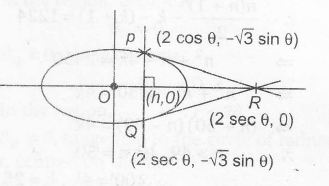Answer:
Option A
Explanation:
Concept involved
As to maximise or minimise area of triangle we sholud find area is terms of parametric coordinate and we second derivative test.
Here , tangent at $P(2\cos\theta,\sqrt{3}\sin\theta)$ is

$\frac{x}{2}\cos\theta+\frac{y}{\sqrt{3}}\sin\theta=1$
$\therefore$ $R(\sec\theta,0)$
$\Rightarrow$ $ \triangle= area of \triangle PQR$
$=\frac{1}{2}(2\sqrt{3}\sin\theta)(2\sec\theta-2\cos\theta)$
$=2\sqrt{3}.\sin^{3}\theta\cos\theta$ .........(i)
Since, $\frac{1}{2}\leq h\leq1,$
$\therefore$ $\frac{1}{2}\leq2 cos \theta\leq1,$
$\Rightarrow$ $\frac{1}{4}\leq cos \theta\leq\frac{1}{2}$
$\therefore$ $\frac{d\triangle}{d\theta}=\frac{2\sqrt{3}\left\{\cos\theta.3\sin^{3}\theta \cos\theta-\sin^{3}\theta(-\sin \theta)\right\}}{\cos^{2}\theta}$
= $\frac{2\sqrt{3}\sin^{2}\theta}{\cos^{2}\theta}[3\cos^{2}\theta+ \sin^{2}\theta]$
= $\frac{2\sqrt{3}\sin^{2}\theta}{\cos^{2}\theta}[2\cos^{2}\theta+ 1]$
= $2\sqrt{3}\tan^{2}\theta(2\cos^{2}\theta+1)>0$
when, $\frac{1}{4}\leq \cos \theta\leq\frac{1}{2}$
$\therefore$ $\triangle_{1}=\triangle_{max}$ occurs at cos $\theta$ = $\frac{1}{4}$
= $\left(\frac{2\sqrt{3}\sin^{3}\theta}{\cos\theta}\right)$
when $\cos\theta=\frac{1}{4}=\frac{45\sqrt{5}}{8}$
$\triangle_{2}=\triangle_{min}$ occurs at cos $\theta$ = $\frac{1}{2}$
= $\left(\frac{2\sqrt{3}\sin^{3}\theta}{\cos\theta}\right)$
when $\cos\theta=\frac{1}{2}=\frac{9}{2}$
$\therefore$ $\frac{8}{\sqrt{5}}\triangle_{1}-8\triangle_{2}=45-36=9$